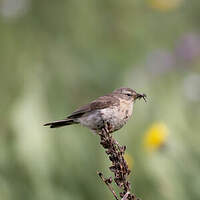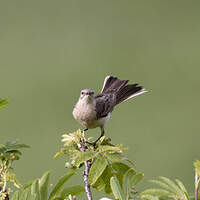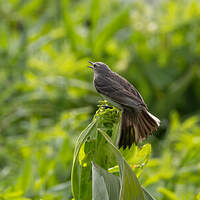Water Pipit
Anthus spinoletta - Pipit spioncelle
Identification
The Water Pipit is a medium-sized pipit, a bit bigger than the pipit for example. In the nuptial plumage, it is characteristic and unmistakable. However, in the internuptial or first winter plumage, it has a certain similarity with the other pipits and one must pay attention to the distinctive criteria.
The adult of the nominal subspecies can easily be recognized by its gray head marked with a very visible white eyebrow, its pale pink chest and its blackish legs. That is enough.
Let's still take a look at the rest in detail. The eye is circled with white and the completely black beak is long, like a dagger. The upper parts are of a rather cold brown-grey, vaguely striped with dark, except for the russet-colored rump. The throat, the sides of the neck and the chest are invaded by pale pink, more pronounced in the male. The flanks are slightly striated. The female has the head slightly less gray, the pink of the lower part less intense and its flanks slightly more striated. The belly and the undertail are white. The wings and tail are dark brown. On the former, you can see an alar bar due to the dark very dark medium coverts and another less distinct on the large coverts. On the tail, it can be seen that the two outer pairs of rectrices show white. The outermost one has the whole outer vane white and the next one just has white at the tip. This can be seen well when taking off or during grooming. The legs are dark brownish-red in good light, otherwise blackish. The adults of the two other subspecies differ slightly in terms of plumage color, but we will not go into these details.
The internuptial adult loses the beautiful gray tone of the head and the pink below. The upper parts are brown with a slight alternation of medium and dark brown zones.In new plumage, the wings feathers are fringed with chamois. The blackish-brown middletop coverts ending in white are well visible on the side. The undersides are white, slightly tinged with rufus on the flanks. Quite fine, dark brown streaks spread over the chest and flanks. The head keeps a clear whitish-rufous eyebrow between the crown and the brown auricular coverts. The beak has yellow on the lower mandible. A thin dark moustache line ends up on each side of the neck to triangular blackish zones surrounding the white throat.
The young bird of first winter looks a lot like the adult inter-nupital. It is even browner above, but mainly, the mantle is now clearly marked in long bands of light and dark, not to the same extent as the Water Pipit, but still visible. The underside, often more rufous is still more streaked than the adult's. The legs are redish.
Subspecific information 3 subspecies
- Anthus spinoletta spinoletta (c and s Europe)
- Anthus spinoletta coutellii (Turkey, the Caucasus and n Iran)
- Anthus spinoletta blakistoni (s Russia and e Kazakhstan to sc Siberia, Mongolia and c China)
Foreign names
- Pipit spioncelle,
- Bisbita alpino,
- petinha-ribeirinha,
- Bergpieper,
- havasi pityer,
- Waterpieper,
- Spioncello,
- vattenpiplärka,
- Vannpiplerke,
- ľabtuška vrchovská,
- linduška horská,
- Bjergpiber,
- vuorikirvinen,
- grasset de muntanya,
- Fjalltittlingur,
- siwerniak,
- ūdeņu čipste,
- vriskarica,
- Горный конёк,
- ヒガシヨーロッパタヒバリ,
- 水鹨,
- vattenpiplärka,
- 水鷚〔小水鷚,褐色鷚〕,
Voice song and call
Pipits get their name from their vocalizations, as we'll see. The call is a loud psit, often repeated upon taking off flight (psit psit > pipit) and heard again while in flight. It is less sharp and less high-pitched than the equivalent call of the Meadow Pipit. The alarm call near the nest is a pressed tsip, repeated indefinitely as long as the danger persists with tsip tsip tsip....
The song is typically that of a Water Pipit. It is sung in flight and begins with a sequence of tsi tsi tsi... accelerating and followed by tsiu tsiu tsiu... descending in tonality until the final landing.
Habitat
The typical nesting habitat is composed of alpine meadows and pastures adorned with rocks, some bushes and a few trees, wetter areas mainly between 1400 and 2500 metres in the alpine massif.
Behaviour character trait
The Water Pipit, like all the Motacillidae, continually waves its tail up and down when it is active and even when it is still but attentive to its surroundings.
Like many other passerines, the Water Pipit becomes gregarious after the breeding season. Migrators move in groups. Wintering birds frequent the water's edge in groups. In case of danger, they group together to take shelter in trees or shrubs. They spend the night in groups in dormitories in the reeds. Its groups are less homogeneous and less numerous than those of the skylark, for example, since the Water Pipit is less sociable by nature. The bird is also more shy towards humans. Perhaps this is a consequence of its life in the mountains.Flight
Fast and undulating flight is used for long-distance travel, for instance during migration. Energetic flapping of the wings, especially when taking off. The male Water Pipit uses its large wing area due to long tertials to easily fly while singing and gliding in curves and arches to the rock or bush that serves as a perch. It is capable of brief hovering flights.
Dietfeeding habits
The Water Pipit mainly feeds on invertebrates. The list of potential prey is very long. Of course, insects come first, especially in the summer, with Diptera in a prominent position, followed by spiders, myriapods, small crustaceans, small mollusks, worms, etc.
Some berries and seeds are also consumed.Winter diet is naturally different due to the frequented habitats. Aquatic taxa are added to already a long list, for example amphipod crustaceans, aquatic insect larvae, aquatic annelids. It has been proven that the bird can also consume algae, which is quite surprising.
Reproduction nesting
The breeding season starts late, at the end of April and ends in July. Second clutches are possible in good environmental conditions.
The male defends its territory by singing in flight while the female looks for a suitable nesting site. She is in charge of the nest building. She chooses a well-sheltered spot, often against a tuft of grass, under a small bush, against a protective rock or even at the entrance of an abandoned burrow. The nest is made of grass, small stems, moss and is lined with fur. The female lays 4 to 6 olive eggs heavily speckled in chestnut-brown which she incubates for 15 days. The male brings food for the female during the incubation period. Later, the couple feed together the recently hatched chicks until they leave the nest at the age of 15 days. In Europe, a study showed that 40% of the nests were predated by the stoat, common at altitudes.Geographic range
The Water Pipit is a mountain bird inhabiting Central and Southern European mountains (ssp nominale), Turkish mountains, the Caucasus and the northern Iranian mountains (ssp coutellii), eastern mountain ranges spanning Kazakhstan and NE China, southern Russia and Mongolia as well as Central China (ssp blakistoni). The northern and NE birds as well as those at high altitudes are migratory, wintering both lower in altitude and further south. The winter range includes all of Western Europe with temperate climate, the Mediterranean coast, Red Sea coast, Persian Gulf coast, southern Central Asia as well as southern and SE China.
Threats - protection
IUCN conservation status
concern
in the Wild
threatened
evaluated
The Water Pipit is a common species where it is found. It is its high-altitude habitat that naturally restricts its distribution. It is not currently threatened.
Sources of information
- IOC World Bird List (v15.1), Gill, F and D Donsker (Eds). 2025-12-07.
- Les passereaux d'Europe, tome 2, P. Géroudet, M. Cuisin
- Pipits and Wagtails of Europe, Asia and North America, Alström Per and Mild Krister
- Avibase, Lepage Denis
- Birds of the World, The Cornell Lab of Ornithology
- xeno-canto, Sharing bird sounds from around the world,
Other sources of interest
 Specification sheet created on
25/07/2023 by Jean François
Specification sheet created on
25/07/2023 by Jean FrançoisTranslation by AI Oiseaux.net
© 1996-2025 Oiseaux.net
- Accipitriformes
- Aegotheliformes
- Anseriformes
- Apodiformes
- Apterygiformes
- Bucerotiformes
- Caprimulgiformes
- Cariamiformes
- Casuariiformes
- Charadriiformes
- Ciconiiformes
- Coliiformes
- Columbiformes
- Coraciiformes
- Cuculiformes
- Eurypygiformes
- Falconiformes
- Galliformes
- Gaviiformes
- Gruiformes
- Leptosomiformes
- Mesitornithiformes
- Musophagiformes
- Nyctibiiformes
- Opisthocomiformes
- Otidiformes
- Passeriformes
- Pelecaniformes
- Phaethontiformes
- Phoenicopteriformes
- Piciformes
- Podargiformes
- Podicipediformes
- Procellariiformes
- Psittaciformes
- Pterocliformes
- Rheiformes
- Sphenisciformes
- Steatornithiformes
- Strigiformes
- Struthioniformes
- Suliformes
- Tinamiformes
- Trogoniformes


































